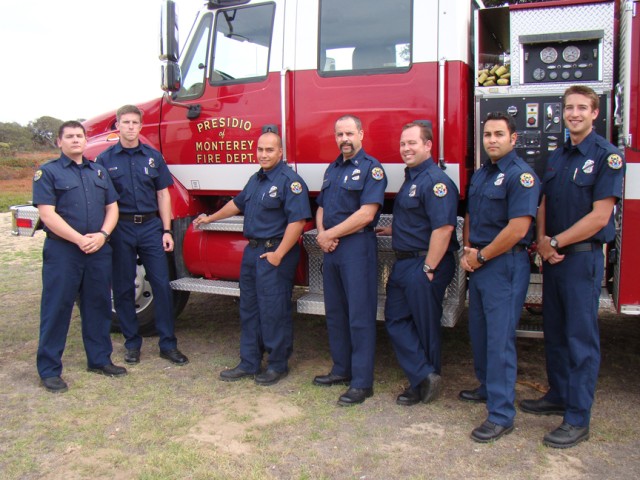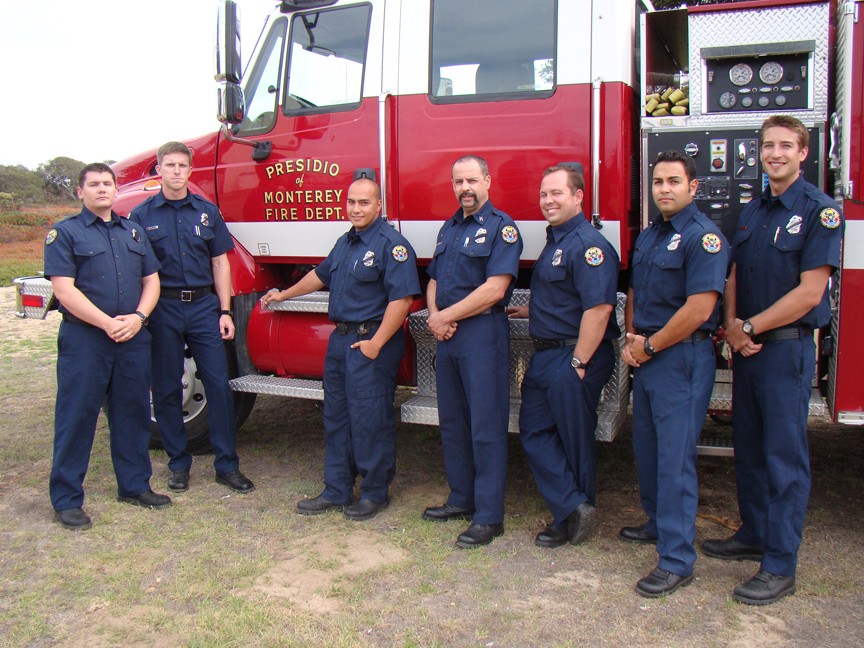
FIVE MEMBERS of the Presidio of Monterey Fire Department took second place in Firefighter Combat Challenge regional finals held in Fremont, Calif., July 18. The five -- Alex Rivera, Mark Stephenson, Effren Villa, Robert Farren and Ramon Rivera -- secured their spot to compete in the World Event to be held in Nov. 16-20 at Las Vegas, Nev.
According to Presidio Fire Chief Jack Riso, the Firefighter Combat Challenge is an example of the essence of firefighting, a race against time. Time is the mortal enemy of firefighters, since fire doubles in size every 90 seconds. The Challenge is a spirited, friendly competition that demonstrates the nature of the job, the levels of fitness required to perform the job and the kind of people who will put themselves in harm\'s way to protect life and property.
"We are prepared to be the force in this year's world competition" stated Alex Rivera, Team Captain "We are learning more and more each day and finding ways to better improve ourselves."
The team has been training at a simulated course set up at Travis Air Force Base with other teams from the northern California region to include reigning world Champions Team Norcal.
"Team Norcal, Team Hayward and Team Travis have been showing us the ropes and helping us improve" said Rivera. The team will put more of an emphasis on conditioning and technique, all the little things needed to compete.
"It's a matter of seconds that separate the winners from the losers. We are focusing on capturing those seconds" stated Rivera.
The team has been sponsored by Pinnacle for the past three years and is grateful for their interest.
"Pinnacle has been wonderful! Their support of us has been above and beyond and we are proud to represent them as well as our men and women in uniform defending our country" said Rivera. "We want to produce a team that the Presidio of Monterey and Pinnacles can be proud of."
Firefighters Mark Stephenson and Robert Farren first time competitors were both excited to be on this year's team and extremely pleased at the team's performance. Stephenson whose relay position was the hose drag/pull, said he could not believe the level of completion. We were to compete against some of the best teams in the world. To be able to compete against such fine firefighters was an honor and joy. For me to help our team place this high and qualify for the world championships is extremely gratifying.
Robert Farren who recently completed his probationary term with the department was impressed with the many firefighters from all over who traveled to compete in this regional final.
"I was nervous about the competion since this is my first one," Farren said. "I was just hoping not to make any mistakes in the hose hoist."
Farren also stated he was surprised at the intensity of the of competion, but soon found out that once the competion was over, the solidarity of firefighters arose and camaraderie he enjoyed with those he ran against was extremely rewarding.
The Challenge is composed of five tasks simulating actions taken at a structural fire. Carrying heavy objects is a daily requirement of firefighters.
The first event, the 45-pound hose pack carry, is a common task in high-rise buildings. Elevators are potentially dangerous, so all firefighters must be prepared to climb stairs with their equipment. Once inside the building and on the floor below the fire, the "high-rise pack" is connected to the water supply and used to attack the fire at the seat of the blaze. In the Challenge, competitors climb a five-story scaffolding tower and deposit the 45-pound hose pack in a square on the top floor.
The hose hoist is representative of those life-critical tasks that tasks such employ ropes. While few firefighters might be expected to pull up a hose roll, more importantly, they may be required to use ropes in a water rescue, cave-in, collapse or confined-space rescue. Competitors pull a 45-pound donut roll of hose to the top of the tower, hoist it over the rail and drop it in a designated square. The weight of the hose roll is 50 pounds, about one-fourth the weight of a 200-pound victim. This rescue task could be performed by a four-person team.
Forcible entry is widely practiced, whether it is to gain access to a closed building or opening the roof of a burning house to allow the superheated gases to escape. The bio mechanics of the Keiser force machine station or, as it is better known, "the Slammer," are nearly identical to a host of other hand tool evolutions that require a combination of upper body strength and power. After descending to the bottom of the tower, touching every step along the way, competitors proceed to the forcible entry machine where they must advance a 160-pound beam five feet, using an eight-pound shot mallet. Many fire ground evolutions. such as opening a roof, require upwards of 100 strokes to accomplish the task. While the power saw might be the tool of choice, the fire axe is always going to be the backup since it has no moving parts, requires little maintenance, and unlike the motorized version, will always start.
Dragging charged hose lines at the scene of a fire is a common practice. When filled with water, the weight can be significant. The hose is very abrasive-resistant with a lowered drag coefficient. When the hose is fully extended, the firefighter is dragging over 200 pounds. To demonstrate the difficulty of this task, competitors pick up a charged hose line and advance it 75 feet. At this point, the competitors must crack the nozzle, hit the target with the water stream, shut down the nozzle and place it down before proceeding to the final task.
Rescuing a victim is the most difficult task that any firefighter is expected to perform. While rescue tasks are usually performed in teams, one of the firefighter's most critical and essential functions is to be capable of effecting the rescue of a partner. As a grand finale, competitors must drag a 175-pound Rescue Randy mannequin a distance of 100 feet. Competitors complete the course once they and the mannequin completely cross the finish line. We sometimes call this portion of the contest the "human tractor pull." Some of the lighter competitors end up hauling 80 pounds more than their own body weights. In these cases, we call this the "ant drill."
All competitors must wear full NFPA-approved turnout gear, including structural helmet, coat and pants with liners, gloves and boots. In addition, they are hooked up to a self-contained breathing apparatus (SCBA) which is provided to them during the competition. If any item becomes removed during the competition it must be retrieved and replaced before the competitor is able to advance.
A strict set of rules and guidelines are enforced during the competition to guarantee the safety of each competitor. Timers and judges monitor the competition to record times and penalize competitors for infractions. Many of the firefighters who compete in the Challenge can perform the five tasks in less than two minutes. Some competitors can actually perform the Challenge in less than 90 seconds, as did the Presidio firefighters.

Social Sharing